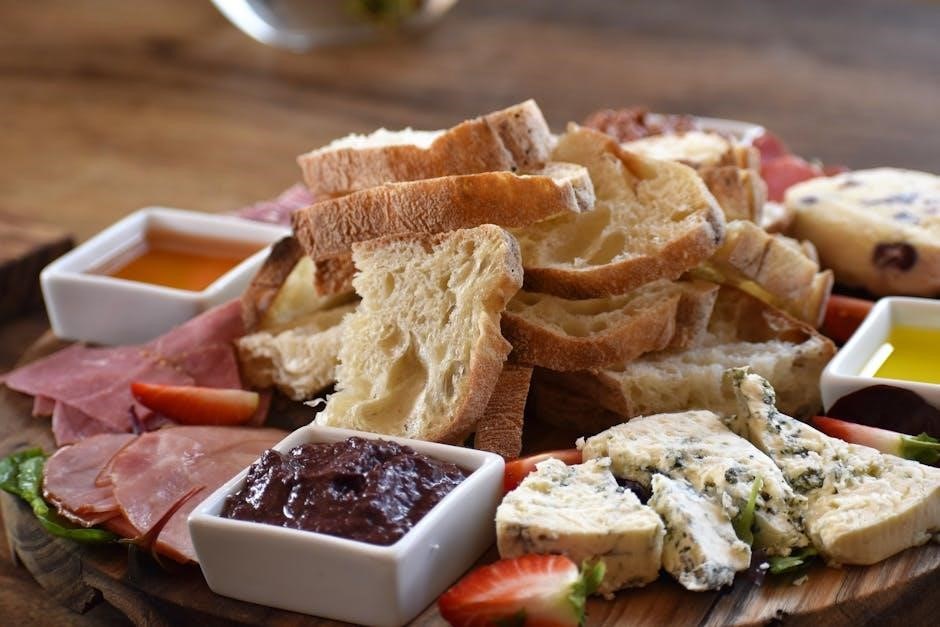The Dominance Playbook is a comprehensive guide to achieving market leadership and sustained success․ It outlines strategies, psychological insights, and tools for businesses to thrive in competitive environments․
1․1 Overview of The Dominance Playbook
The Dominance Playbook is a strategic guide designed to help businesses, leaders, and individuals achieve and maintain dominance in their respective fields․ It provides a roadmap for understanding market dynamics, leveraging psychological principles, and building strong brand identities․ The playbook emphasizes the importance of competitive intelligence, adaptive strategies, and technological integration to outpace rivals․ By focusing on actionable insights and real-world applications, it empowers users to navigate complex environments and sustain long-term success․ The playbook is tailored for both established organizations and emerging players seeking to elevate their position in competitive landscapes․
1․2 Historical Context and Evolution
The Dominance Playbook has evolved significantly over time, drawing from historical strategies used by successful leaders and organizations․ Rooted in principles of competitive advantage, it traces back to early business and military tactics․ Over decades, it has incorporated modern psychological insights, technological advancements, and data-driven approaches․ The playbook has adapted to changing market dynamics, emphasizing adaptability and innovation․ Its evolution reflects the growing complexity of global competition, offering timeless strategies refined for contemporary challenges․ This historical context underscores its relevance as a dynamic guide for achieving and sustaining dominance in ever-evolving landscapes․
1․3 Key Objectives and Target Audience
The Dominance Playbook is designed to empower businesses, leaders, and entrepreneurs with actionable strategies to achieve market dominance․ Its primary objective is to provide a roadmap for outperforming competitors and creating lasting value; The target audience includes executives, managers, and decision-makers seeking to elevate their organizations․ It also caters to individuals aiming to enhance their leadership skills and strategic thinking․ By focusing on real-world applications, the playbook serves as an essential resource for anyone navigating competitive landscapes․ Its clear, concise approach ensures accessibility for both seasoned professionals and newcomers, making it a versatile tool for achieving success in diverse industries and contexts․
1․4 Importance of Dominance in Modern Strategy
Dominance in modern strategy is crucial for securing a competitive edge and ensuring long-term success․ In today’s fast-paced, globalized markets, achieving dominance enables businesses to influence industry trends, dictate standards, and capture significant market share․ It fosters innovation, efficiency, and resilience, allowing organizations to adapt to changing landscapes․ Dominance also enhances brand reputation, customer loyalty, and negotiating power․ By establishing a strong position, companies can set the terms of competition and create barriers to entry for rivals․ This playbook emphasizes that dominance is not just about growth but also about sustaining it through strategic foresight and continuous improvement, making it indispensable for thriving in dynamic environments․

Core Strategies for Achieving Dominance
Core strategies for achieving dominance involve in-depth market analysis, leveraging competitive intelligence, applying psychological principles of influence, building strong brand identity, and utilizing advanced technology for a competitive edge․
2․1 Market Analysis and Competitive Intelligence
Market analysis and competitive intelligence are foundational to dominance․ They involve identifying market trends, understanding customer needs, and analyzing competitors’ strengths and weaknesses․ By gathering and interpreting data, businesses can anticipate market shifts, uncover opportunities, and develop strategies to outperform rivals․ Tools like SWOT analysis, Porter’s Five Forces, and data analytics are essential for this process․ This intelligence enables companies to refine their offerings, optimize pricing, and enhance their competitive positioning․ Regular monitoring of the competitive landscape ensures sustained relevance and adaptability, helping businesses maintain a strategic edge in dynamic environments․ Ethical practices in data collection and analysis are crucial to ensure reliability and integrity․
2․2 Psychological Principles of Influence
Psychological principles of influence are crucial for establishing dominance․ They leverage human behavior, cognition, and emotions to shape decisions․ Key principles include authority, reciprocity, social proof, and scarcity․ By aligning strategies with these principles, businesses can enhance persuasion and loyalty․ Understanding cognitive biases, such as anchoring and framing effects, helps in crafting compelling narratives․ Emotional appeals, like fear or exclusivity, can drive engagement․ Ethical use of these principles ensures trust and long-term success․ Dominant players often master these tactics to influence market dynamics and consumer behavior effectively․ This section explores how to apply these principles strategically while maintaining ethical standards and fostering positive relationships․ They are essential for building and sustaining a competitive edge․
2․3 Building a Strong Brand Identity
Building a strong brand identity is foundational for dominance․ It involves crafting a unique, memorable, and consistent image that resonates with your target audience․ Key elements include a clear mission, vision, and values, along with a compelling narrative․ Consistency across all platforms ensures recognition and trust․ A strong brand identity differentiates you from competitors, creating emotional connections with customers․ Effective storytelling and visual elements amplify brand impact․ Investing in brand equity fosters loyalty and long-term growth․ This section explores strategies to develop and maintain a powerful brand identity that drives engagement and sets you apart in competitive markets, ensuring sustained relevance and customer loyalty․ It is essential for achieving and maintaining dominance․

2․4 Leveraging Technology for Competitive Edge
Leveraging technology is a cornerstone of modern dominance strategies․ Advanced tools and platforms provide insights into market trends, enabling data-driven decisions․ Automation enhances operational efficiency, reducing costs and improving scalability․ Technology also fosters innovation, allowing businesses to adapt quickly to changing landscapes․ By integrating cutting-edge solutions, companies can streamline processes, enhance customer experiences, and outpace competitors․ Investing in technology ensures a future-ready approach, driving sustainable growth and maintaining a competitive edge․ This section explores how to harness technology effectively, from analytics to automation, to achieve and sustain dominance in dynamic markets, ensuring long-term success and resilience against evolving challenges․
Advanced Tactics for Sustaining Dominance
Advanced tactics involve strategic adaptability, leveraging innovation, and maintaining market leadership through continuous improvement and resilience, ensuring long-term dominance in ever-changing competitive landscapes․
3․1 Disrupting Competitors’ Strategies
Disrupting competitors’ strategies involves identifying and countering their plans to gain a strategic advantage․ Analyze rivals’ weaknesses and market positions to exploit gaps in their approaches․ Proactively innovate to render competitors’ offerings obsolete․ Use strategic marketing campaigns to undermine their market share and influence․ Employ dynamic tactics to stay ahead, such as rapid product iterations or exclusive partnerships․ Leverage real-time data to anticipate and respond to competitor moves swiftly․ Foster collaboration with industry leaders to create barriers to entry for new competitors․ Maintain ethical practices to ensure long-term trust and reputation․ Continuous adaptation and bold moves are essential to sustain dominance and keep competitors off balance․
3․2 Mastering the Art of Negotiation
Mastering negotiation is a cornerstone of dominance, enabling individuals and organizations to secure favorable outcomes․ Effective negotiation requires active listening, empathy, and a deep understanding of the counterpart’s needs․ Preparation is key—know your goals, alternatives, and the opponent’s potential moves․ Separate people from issues to avoid emotional conflicts․ Use objective criteria to anchor discussions and create mutually beneficial solutions․ Employ strategies like anchoring, mirroring, and strategic concessions to influence outcomes․ Cultivate relationships to build trust and long-term collaboration․ In business, negotiations can make or break deals, so refining these skills is essential for sustained success and maintaining a competitive edge in dynamic markets․
3;3 Utilizing Data-Driven Decision Making
Data-driven decision making is a critical component of sustaining dominance․ By leveraging analytics and insights, businesses can make informed choices that align with strategic goals․ Advanced tools and technologies enable organizations to process large datasets, uncover patterns, and predict trends․ Real-time data provides agility, allowing quick responses to market shifts․ Accurate and timely decisions enhance efficiency, reduce risks, and foster innovation․ Dominant players rely on data to identify opportunities, optimize operations, and outperform competitors․ Balancing intuition with factual insights ensures a balanced approach․ In a competitive landscape, data-driven strategies are essential for maintaining a leadership position and achieving long-term success․ They empower organizations to act decisively and stay ahead in evolving markets․
3․4 Maintaining Adaptability in Changing Markets
Maintaining adaptability is crucial for sustaining dominance in dynamic environments․ Businesses must remain flexible to respond to shifting market conditions, consumer preferences, and technological advancements․ Continuous learning and innovation are essential to stay ahead․ Organizations should foster a culture of agility, enabling quick pivots without compromising core objectives․ Regularly monitoring industry trends and customer feedback helps anticipate changes․ Streamlined decision-making processes and decentralized authority empower teams to act swiftly․ Adaptable companies leverage diverse strategies to mitigate risks and capitalize on opportunities․ By embracing change and evolving alongside the market, businesses can maintain their competitive edge and reinforce their dominance․ Adaptability ensures long-term resilience and relevance in an ever-changing world․

Case Studies of Successful Dominance

Explore real-world examples of companies and leaders achieving dominance across industries․ These case studies reveal strategies, challenges, and lessons learned, offering valuable insights for aspiring dominants․
4․1 Analysis of Dominant Companies in Tech
Dominant tech companies like Apple, Amazon, Google, and Microsoft exemplify strategic excellence․ Apple’s innovation and brand loyalty, Amazon’s customer-centric scaling, Google’s data-driven dominance, and Microsoft’s adaptability highlight unique paths to supremacy; These firms leverage cutting-edge technology, strong brand identities, and continuous innovation to maintain leadership; Their ability to disrupt markets, acquire strategic assets, and foster ecosystems ensures sustained growth․ By analyzing their strategies, businesses can glean insights into achieving and maintaining dominance in competitive tech landscapes․
4․2 Lessons from Sports and Leadership
Sports and leadership offer valuable insights into dominance․ Teams like the New England Patriots and athletes like LeBron James exemplify sustained success through discipline, innovation, and strategic planning․ Leaders in sports foster strong team cultures, emphasizing clear vision, accountability, and adaptability; Coaches such as Bill Belichick and Nick Saban demonstrate how preparation, mental resilience, and decision-making under pressure lead to consistent dominance․ These lessons translate to business, where leaders must inspire, motivate, and align teams toward common goals․ By studying these examples, organizations can adopt winning mindsets and strategies to achieve and maintain dominance in their respective fields․
4․3 Military Strategies and Their Business Applications
Military strategies provide timeless lessons for achieving dominance․ Sun Tzu’s The Art of War emphasizes knowing the terrain, adapting tactics, and exploiting weaknesses—principles applicable to competitive markets․ Techniques like the “element of surprise” and “divide and conquer” can disrupt competitors․ Modern military concepts, such as “mission command,” highlight decentralized decision-making, fostering agility․ Leaders like Napoleon and Patton exemplify visionary planning and execution․ These strategies translate to business through robust market analysis, strategic positioning, and calculated risk-taking․ By adopting a warrior mindset, organizations can outmaneuver rivals, secure resources, and maintain long-term dominance in volatile landscapes․ Military precision and discipline offer a roadmap for businesses to thrive in competitive arenas․
4․4 Examples from the World of Politics
Political dominance offers valuable insights into strategic leadership and power dynamics․ Successful political campaigns often rely on clear messaging, emotional appeals, and coalition-building—strategies that mirror business tactics․ Politicians master narrative control, framing issues to sway public opinion, akin to branding in business․ Long-term vision and adaptability are crucial, as seen in policymakers adjusting strategies to maintain support․ Political leaders also leverage data-driven decision-making, using polls and feedback to refine approaches․ Dominance in politics often requires balancing diverse interests while maintaining a cohesive agenda, a skill transferable to managing stakeholders in business․ These examples highlight how political strategies can inspire businesses to navigate complex landscapes and achieve sustained dominance․

The Role of Innovation in Dominance
Innovation is a cornerstone of dominance, driving growth, adaptability, and market leadership․ It enables businesses to leverage technology, foster creativity, and deliver unique value, ensuring long-term success․
5․1 Fostering a Culture of Innovation
Fostering a culture of innovation requires leadership commitment, open communication, and psychological safety․ Encourage employees to ask questions, explore new ideas, and experiment without fear of failure․ Promote collaboration across teams, leveraging diverse perspectives to drive creativity․ Empower individuals by providing resources, training, and autonomy to pursue innovative solutions․ Recognize and reward innovative efforts, even if they don’t lead to immediate success․ Continuous learning and growth opportunities are essential to sustain a culture of innovation․ By cultivating a mindset that embraces change and experimentation, organizations can unlock their full potential and stay ahead in competitive markets․ Innovation thrives in environments where curiosity is valued and creativity is nurtured․
5․2 Investing in Research and Development
Investing in research and development (R&D) is a cornerstone of achieving and maintaining dominance․ Consistent R&D investment drives innovation, leading to new technologies, products, and services that set organizations apart․ It fosters a competitive edge by anticipating market trends and customer needs․ Allocating resources to R&D ensures long-term growth and adaptability․ Companies that prioritize R&D often see enhanced brand reputation and customer loyalty․ However, R&D requires strategic planning, clear objectives, and continuous monitoring to ensure alignment with business goals․ Balancing short-term gains with long-term investments is key to maximizing R&D impact․ Dominant organizations understand that R&D is not just an expense but a critical driver of sustainable success․
5․3 Failing Fast and Learning Faster
Failing fast and learning faster is a critical component of sustaining dominance․ Embracing failure as a stepping stone to success allows organizations to experiment, iterate, and refine strategies quickly․ This approach fosters agility and adaptability, enabling businesses to respond to market changes and competitor actions swiftly․ By failing fast, companies avoid prolonged investments in ineffective strategies and redirect resources toward more promising opportunities․ Learning faster involves capturing insights from failures, analyzing what went wrong, and applying these lessons to future endeavors․ This mindset not only accelerates innovation but also builds resilience, ensuring long-term dominance in competitive landscapes․ Organizations that embrace this philosophy are better equipped to thrive in dynamic environments․
5․4 Protecting Intellectual Property
Protecting intellectual property (IP) is essential for maintaining dominance in competitive markets․ IP, including patents, trademarks, and copyrights, safeguards innovations and prevents competitors from replicating unique offerings․ By securing IP, businesses ensure exclusive rights to their creations, preserving their competitive edge․ This protection fosters trust and credibility, enhancing brand value․ Organizations must also enforce IP rights through legal measures and strategic agreements, such as non-disclosure agreements, to prevent unauthorized use․ Additionally, understanding and leveraging IP portfolios can create new revenue streams and strategic opportunities․ In a globalized economy, robust IP protection is vital for sustaining long-term dominance and fostering continuous innovation․
Ethical Considerations and Challenges
Ethical considerations in dominance involve balancing power with responsibility, ensuring fair practices, and maintaining trust․ Challenges include navigating moral dilemmas and societal expectations while pursuing growth․
6․1 Ethical Dilemmas in Pursuing Dominance
Pursuing dominance often raises ethical dilemmas, such as balancing competitive advantage with fair practices․ Companies may face challenges like exploiting market power, prioritizing profits over consumer welfare, or engaging in monopolistic behaviors․ Ethical concerns also arise when dominance leads to the suppression of smaller competitors or innovation stiflement․ Transparency and accountability become critical to maintain trust and ethical standards․ Leaders must navigate these complexities to ensure sustainable growth while upholding moral principles․ Addressing these dilemmas requires a proactive approach to self-regulation and adherence to ethical guidelines, fostering a culture that values fairness and long-term societal benefits over short-term gains․

6․2 Managing Public Perception and Reputation

Managing public perception and reputation is crucial for maintaining dominance․ Companies must align their actions with societal values to foster trust and loyalty․ Transparent communication, ethical practices, and consistent messaging help shape a positive image․ Crisis management strategies are essential to mitigate reputational damage․ Engaging with stakeholders, addressing concerns, and showcasing social responsibility can enhance public perception․ A strong brand identity and leadership visibility further reinforce reputation․ Monitoring digital presence and responding to feedback are vital in today’s connected world․ Ultimately, balancing dominance with ethical behavior ensures long-term reputation management and sustained success․
6․3 Addressing Regulatory and Legal Challenges
Addressing regulatory and legal challenges is essential for maintaining dominance․ Companies must navigate complex legal frameworks, ensuring compliance with laws and regulations․ Staying informed about policy changes and industry standards helps mitigate risks․ Intellectual property protection is critical to safeguard innovations and prevent copying․ Legal teams play a vital role in anticipating and resolving disputes․ Non-compliance can lead to fines, reputational damage, and loss of market position․ Proactive engagement with regulators and adherence to ethical practices foster trust and stability․ By aligning operations with legal requirements, businesses can avoid setbacks and maintain their competitive edge in the marketplace․
6․4 Balancing Dominance with Corporate Social Responsibility
Balancing dominance with corporate social responsibility (CSR) is crucial for long-term success․ Dominant companies must ensure their pursuit of market leadership aligns with ethical practices․ CSR initiatives, such as environmental sustainability and community support, enhance brand reputation and consumer trust․ Ethical business practices foster loyalty and long-term growth․ Transparency in operations builds credibility, while addressing social issues demonstrates leadership․ Dominance without responsibility risks public backlash and regulatory scrutiny․ Integrating CSR into core strategies ensures sustainable success and positive societal impact․ By prioritizing both dominance and social responsibility, companies can achieve market leadership while contributing to a better world․
The Future of Dominance in a Globalized World
Globalization reshapes dominance, emphasizing adaptability and innovation․ Emerging markets and technological advancements create new opportunities, while requiring leaders to navigate cultural and regulatory complexities effectively․

7․1 Emerging Markets and New Opportunities
Emerging markets represent a frontier of untapped potential for dominance․ Globalization has opened doors to regions with rapid economic growth and evolving consumer needs․ These markets present unique opportunities for businesses to expand their influence and establish early-mover advantages․ However, navigating these territories requires tailored strategies that account for cultural, economic, and regulatory differences․ Innovation and adaptability are key to capturing market share in these dynamic environments․ Companies that invest in understanding local dynamics and leveraging technology can position themselves for long-term success․ Emerging markets also drive the adoption of new technologies, creating a fertile ground for disruptive business models․ Organizations must balance global consistency with local customization to thrive in these diverse landscapes․
7․2 The Impact of Globalization on Dominance
Globalization has profoundly reshaped the landscape of dominance, creating both opportunities and challenges for businesses․ It fosters interconnected markets, enabling companies to expand their reach and access new consumer bases․ However, it also intensifies competition, as firms from diverse regions vie for market share․ To maintain dominance, businesses must adapt to global trends, such as shifting consumer preferences and evolving regulatory frameworks․ The ability to navigate cultural differences and leverage global supply chains becomes critical․ Additionally, technological advancements, accelerated by globalization, play a pivotal role in enabling companies to scale and innovate․ While globalization offers vast potential for growth, it demands a strategic and agile approach to sustain dominance in an increasingly interconnected world․
7․3 Adapting to Changing Consumer Behaviors
Understanding and adapting to changing consumer behaviors is crucial for sustaining dominance in a dynamic market․ Shifts in preferences, driven by technological advancements and cultural trends, require businesses to be highly responsive․ Companies must invest in consumer insights and data analytics to anticipate and meet evolving demands․ Personalization, sustainability, and digital engagement are key areas where consumer expectations are rising․ By aligning strategies with these trends, businesses can strengthen their market position․ Continuous innovation and a customer-centric approach are essential to remain relevant and maintain a competitive edge․ Proactively addressing these changes ensures long-term success and dominance in an ever-evolving marketplace․
7․4 Preparing for Future Challenges and Trends
Preparing for future challenges and trends is essential for maintaining dominance in an ever-evolving global landscape․ Businesses must stay ahead by anticipating shifts in technology, consumer preferences, and market dynamics․ Investing in research and development, fostering innovation, and embracing agility are critical strategies․ Companies should also monitor geopolitical changes and economic fluctuations that could impact their operations․ By building resilient systems and cultivating a forward-thinking mindset, organizations can navigate uncertainties and capitalize on emerging opportunities․ Continuous learning and adaptability are key to staying ahead of the curve and ensuring long-term success in an increasingly competitive and interconnected world․
The Dominance Playbook concludes by emphasizing the importance of adaptability, continuous learning, and strategic foresight in maintaining long-term success and leadership in competitive landscapes․

8․1 Summarizing Key Takeaways
The Dominance Playbook underscores the importance of adaptability, innovation, and strategic foresight in achieving and maintaining dominance․ It highlights the need to leverage psychological principles, technological advancements, and data-driven decision-making to outpace competitors․ The playbook also emphasizes the ethical considerations and challenges of pursuing dominance, ensuring that success aligns with corporate social responsibility․ By fostering a culture of innovation and continuously learning from failures, organizations can build resilience and sustain long-term leadership․ Ultimately, the playbook provides actionable strategies for businesses, leaders, and individuals to thrive in competitive landscapes while balancing dominance with integrity and societal impact․
8․2 Encouraging Continuous Learning and Growth
Continuous learning and growth are essential for sustaining dominance in any field․ Organizations must foster a culture where employees are encouraged to expand their skills and knowledge․ This can be achieved through regular training programs, workshops, and access to educational resources․ Leaders should prioritize mentorship and create opportunities for professional development․ Encouraging innovation and experimentation allows individuals to explore new ideas and adapt to changing environments․ By fostering a growth mindset, organizations can stay ahead of the curve and ensure long-term success․ Continuous learning not only enhances individual capabilities but also drives collective progress, making it a cornerstone of sustained dominance․
8․3 Final Words on Achieving and Sustaining Dominance
Achieving and sustaining dominance requires a relentless pursuit of excellence, adaptability, and resilience․ Organizations must embrace change, innovate continuously, and align their strategies with long-term vision․ Dominance is not a destination but a journey, where staying ahead of competitors and meeting evolving market demands are critical․ Cultivating strong leadership, fostering collaboration, and prioritizing ethical practices ensure sustained success․ Continuous learning and growth, both individually and collectively, are vital․ By maintaining focus, leveraging opportunities, and overcoming challenges, organizations can solidify their position and thrive in an ever-changing landscape․ Dominance is a mindset, a commitment to excellence, and a dedication to lasting impact․
8․4 Resources for Further Reading and Study
For deeper insights, explore books like “The Art of War” by Sun Tzu and “Blue Ocean Strategy” by W․ Chan Kim․ Academic journals such as Harvard Business Review offer cutting-edge research on dominance strategies․ Online courses like “Strategic Management” on Coursera provide practical skills․ Websites like Forbes and McKinsey & Company regularly publish articles on market leadership․ Additionally, case studies from MIT Sloan Management Review and Strategy+Business offer real-world examples of dominance in action․ These resources collectively provide a comprehensive toolkit for mastering dominance and staying ahead in competitive landscapes․


















































